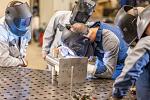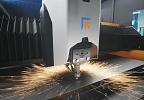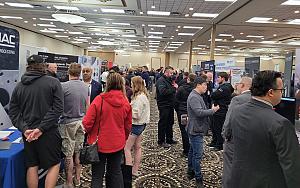- FMA
- The Fabricator
- FABTECH
- Canadian Metalworking
Fiber Fix
Faster cutting speeds and higher energy efficiencies are making fiber laser cutting the system of choice for thin sheet metal
- December 7, 2010
- News Release
- Fabricating
Fiber laser cutting is making fast inroads into the sheet metal fabrication market in North America because proponents claim that the technology offers faster cutting speeds of up to 40 per cent and higher energy efficiencies of up to 30 per cent over CO2 laser cutting systems on sheet metal thicknesses up to 8 mm (0.31 in.)
Consider 1.85 mm thick Boron steel, a common material used in cutting automotive body and structural components. With a 3 KW fiber laser cutting machine with nitrogen as an assist gas, a fabricator can achieve cutting speeds of 12 m/min. With compressed air as an assist gas, it’s 14 m/min. So you’re looking at a 40 per cent gain above a 4 KW CO2 laser with a 3 KW fiber laser,” explains Carl Bryant, sales and marketing manager for PRIMA 3D Systems, Chicopee, MA.
Bill Shiner, vice president of industrial sales for IPG Photonics, a supplier of fiber laser resonators in North America whose lasers are used in PRIMA, SLT and Salvagnini fiber laser cutting systems, says that a 2 KW fiber laser “can easily outrun a 3 or 4 KW CO2 laser in thin materials. We’re at a point where the fiber laser can outrun many of the laser cutting machines because they [fiber laser resonators] can cut so fast.”
Fiber laser technology is not new; it was introduced in the 1990s for welding and laser marking. What is relatively new to industry in North America is the use of fiber lasers in metal cutting applications. Fiber laser cutting is a European innovation that has been slow to take hold in North America, says Mark Barry, vice president for PRIMA North America, Chicopee, MA.
“There’s a basic relunctancy of people [in North America] to adopt innovation. You can’t show anyone a fiber laser in production for any greater than five years here, and that’s probably an exaggeration.”
One company that embraced the technology in 2000 is Indian laser technology supplier Sahajanand Laser Technology (SLT), Gujarat, India. Arvind Patel, managing director, says SLT was “the first company in the world to offer fiber laser cutting for sheet metal fabrication. SLT exhibited a 1 KW 4 ft by 4 ft (1.2 m x 1.2 m) fiber laser at FABTECH 2007.”
SLT recently set up North American operations with a facility in Dallas, TX.
Fiber lasers are high powered solid state lasers that offer a shorter wavelength (close to the visible spectrum light) compared to CO2 lasers (fiber laser wavelength is 1.07 µm and CO2 laser wavelength is 10.6 µm in the infrared part of the spectrum).
A characteristic of a shorter wavelength is that it’s more readily absorbed into metals, which means higher cutting efficiency. The fiber lasers are generated in a fiber and created or stimulated by pumping light emitting diodes through the fiber to produce the beam of light.
IPG’s Bill Shiner adds that users can expect “better cut sand at higher speed.”
That’s because the “superior beam quality of a fiber laser allows for the use of a longer focal length lens for the same spot size. In addition, the mode quality at focus is very important and from a fiber laser you receive a uniform beam with a flat top mode with no structure on it.”
Since the fiber itself is the resonator, it’s an airtight environment, eliminating possible contamination. “Nothing is exposed to the outside world until
you have to exit the delivery fiber,” explains Steve Aleshin, manager, applications department for Salvagnini, Hamilton, OH.
It also means you don’t have the mechanical and maintenance issues associated with Nd: YAG and CO2 lasers, such as water cooled-systems to control the temperature of the water.
“When you think about maintenance on a CO2, it uses electronics, optics, gas, and water. A solid state fiber laser utilizes electricity, that’s it,” says PRIMA North America’s Mark Barry. “There are no moving parts in the fiber laser. Conventional CO2 lasers have vacuum pumps and turbines that are required to circulate the gas and cool the gas, so there’s a lot of preventative maintenance. Then you have to consider turbine or turbine bearing replacements and that adds into the cost of ownership equation.”
Another advantage is laser beam accuracy. Since the beam of light is being delivered through the fiber, the fiber itself is a constant length. “So no matter how far or close from the source you’re processing, your optical path length never changes, so there is no need for adaptive optics that can
drift over time, get contaminated and need to be replaced,” says Salvagnini’s Steve Aleshin.
SLT’s Arvind Patel says that fiber laser cutting systems are “cost effective solutions for fabricators. They have relatively low maintenance, requires less space compared to conventional CO2 laser cutting systems, and are more rugged, designed to function in varied shop floor environments.”
The big application advantage for fiber laser cutting is with thin materials. Industry experts concur that the technology excels on sheet thicknesses of 8 mm or thinner.
“If you go beyond 8 mm, there is still the advantage of the fact that it’s delivered through fiber, so it has a high wall plug efficiency,” says PRIMA North America’s Mark Barry.
Indeed, Salvagnini president Bill Brossard says that the company has proven technical tables using an IPG 2 KW fiber laser “and we have proven cut capability up to 18 mm thick mild steel.”
And while you can cut materials thicker than 8 mm, the cutting speed advantage is highest on thinner materials, adds Aleshin.
“On thinner gauge steels such as 20-22 gauge mild steel, galvanized, with our 3 KW CO2 laser we’re cutting at 750 ipm. With the fiber laser the speed is 1800 ipm on 22 gauge mild steel. As you approach about a quarter of an inch, the speed advantage becomes equal.”
Salvagnini’s Bill Brossard says that fiber laser cutting has a process advantage in piercing, something that was discovered by the company’s engineers in Italy. Steve Aleshin explains:
“With a CO2 laser pierces, it creates a plasma that actually blocks the CO2 wavelength, so the CO2 wavelength is absorbed by that pierce. So you have to cut the amount of gas because the nitrogen that you’re feeding your cut has an effect on that plasma. The fiber goes through the plasma. The plasma is still created, but the fiber laser wavelength is not absorbed by that plasma and it allows us to get the gas at full pressure and we don’t have to delay between changing the pressure higher or lower as we make that pierce.”
While fiber laser cutting offers many advantages in thin materials, in thicker materials, those advantages disappear
“When you get to 3/8th of a inch or 0.375 in. (9.5 mm) you start to run into some problems, says PRIMA North America’s Mark Barry.
Marco Holzer, product manager for solid state lasers for TRUMPF Laser and Lasersysteme, Ditzingen, Germany, adds that “it is important to have a certain spot diameter of the laser beam to get a die clearance which is large enough so that the waste produced during cutting can be blown out. In other words, this means that the best beam quality and hence a small spot diameter is not always suitable to get the best cutting results.”
He adds that since fiber laser isn’t suitable for all applications, “a laser manufacturer should be proficient in all types of lasers for each material and material thickness. TRUMPF has the broadest spectrum of laser beam sources, including CO2, rod, disc, fiber and diode lasers.”
For thin sheet metal fabrication, TRUMPF offers two types of what it describes as “fiber-guided” solid state lasers, the TruDisk and TruFiber. “This means that the laser is guided through a fiber from the resonator to the workpiece,” explains Holzer. “One difference between the two types of solid state lasers is that the TruFiber uses a fiber as its active media, which is stimulated by a diode. The laser beam of a fiber laser is also fiber-guided. The TruDisk uses a disc.”
A disk laser is a Nd: YAG laser that guides the laser beam through a fiber and is typically designed for applications with laser power of less than 1 kW. Wall plug efficiency of disc lasers is about 15 to 20 per cent versus fiber lasers that offer about 30 per cent wall plug efficiency.
IPG Photonic’s Bill Shiner says fiber laser wall plug efficiency is higher “because the laser only turns on when output is required. In the case of the Nd: YAG disk laser, the laser is running in a simmer mode when output is not required, therefore consuming power when the laser output is not required.”
TRUMPF’s disk laser is designed to cut materials up to 4 mm, while the fiber laser is better suited for cutting foils and thinner materials between 0.05 to 1 mm.
TRUMPF’s Marco Holzer says that the disk laser has advantages when cutting materials in the multi-kilowatt range with high productivity. “There is no sensitivity to reflection that frequently arises when processing material with the laser.”
TRUMPF manufacturers its own laser resonators, while PRIMA NA, Salvagnini and SLT use IPG Photonics fiber laser resonators for their fiber laser cutting systems. One distinction is that PRIMA NA does manufacture Nd: YAG and CO2 lasers through its other divisions.
For the record, PRIMA, Salvagnini and SLT also sell standard CO2 laser cutting machines and while they’re promoting fiber laser cutting technology in the market and see a bright future for the technology (particularly in automotive and aerospace), they recognize that CO2 and Nd: YAG laser cutting systems will continue to be sold since they fit specific application needs.
The one area where fiber lasers have not made any inroads is in hole drilling in the aerospace market, which today is typically achieved using a pulsed Nd: YAG laser. Companies like PRIMA NA, however, are investigating the use of fiber lasers for hole drilling, says Barry.
“All drillers today are pulsed Nd: YAG drillers. If we could change that paradigm and make it so that the fiber laser was applicable to that, then we may be able to create a single machine that could be a driller, a cutter and a welder and that would be a wonderful thing,” says Barry.
The technology is taking off in North America. “We have sold these machines in the US and in Canada,” says Salvagnini’s Bill Brossard. “We shipped our first fiber laser machines into North America in October 2009. We currently have four machines installed, two being delivered and several more being built at the factory.” CM
subscribe now


Keep up to date with the latest news, events, and technology for all things metal from our pair of monthly magazines written specifically for Canadian manufacturers!
Start Your Free Subscription- Trending Articles
Class is in session for college connections

Engine-driven welding machines include integrated air compressors

Compact 2D laser machine designed for smaller shops

Push-feeding saw station cuts nonferrous metals

BlueForge Alliance partners with Nuts, Bolts & Thingamajigs to develop Submarine Manufacturing Camps

- Industry Events
ZEISS Quality Innovation Days 2024
- April 15 - 19, 2024
Tube 2024
- April 15 - 19, 2024
- Düsseldorf, Germany
Lincoln Electric's Large Format 3D Metal Printing Seminar
- April 16 - 17, 2024
- Cleveland, OH
CTMA Economic Uncertainty: Helping You Navigate Windsor Seminar
- April 30, 2024
- Windsor, ON Canada
MME Winnipeg
- April 30, 2024
- Winnipeg, ON Canada















